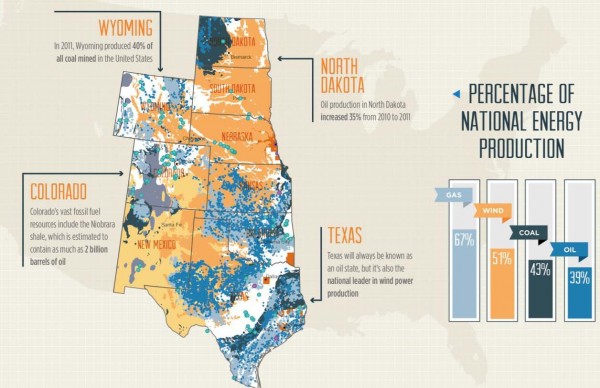Maps of our nation’s energy potential usually display just one source, such as the location of wind farms or the extent of natural gas fields. In an interesting new data visualization, advertising and PR firm Saxum has combined both fossil and renewable energy resources into a map of The United States of Energy.
Below are the front and back of the viz, which has so much info that it probably reads best in hard copy (click on images to enlarge).
The firm describes the project as “the first data visualization piece of its kind to comprehensively detail our nation’s vast and diverse energy portfolio. ” Here’s more from them:
What began as a simple graphic showcasing America’s energy riches quickly grew into a two-sided, folded map concept displaying thousands of individual data points. The #USofEnergy map visualizes our country’s energy potential by charting current sources of energy production and identifying future resources and known deposits. Energy resources surveyed include: natural gas, oil, coal, nuclear, hydroelectric, wind, geothermal, solar and biomass. We compiled the data from a broad range of industry and government sources, including the National Renewable Energy Laboratory, U.S. Geological Survey, U.S. Energy Information Administration, U.S. Army Corps of Engineers, Nuclear Research Council and American Wind Energy Association.
In some parts of the country, such as the nation’s midsection, there are so many different energy sources being exploited that the map is tough to make out. Overlapping layers present a difficulty here, but in other regions, such as the East Coast, there’s a lot of white space.
Saxum, which describes itself as “one of the leading integrated marketing communications agencies in the Great Plains,” highlights that 46 percent of U.S. energy is produced by nine states in the center of the country, as shown below.

It’s worth zooming in to their legend to see what all these layers really mean. With biomass, for example, an entire county is shaded orange if it’s in the top-20 percent for producing energy in this way per square kilometer. With solar, only the best places in the country are shown. Here in Denver, for example, we’re not covered by the solar layer, but photovoltaic panels on the roof of my home/office generate the majority of electricity we consume (see this more detailed solar potential map from the U.S. Department of Energy).
Don’t ask me how, but it would be great to see an online, interactive version of Saxum’s map. That format could let you provide even greater detail on the energy sources, such as varying the size of the points used to display nuclear plants and hydroelectric dams by how much energy they produce, or by allowing users to turn layers on and off. (UPDATE: Saxum has an interactive data visualization here.)
Emily Guerin at High Country News has a good overview of the other trends that Saxum highlights in its map.
If you’re looking for maps of individual energy sources, check out our PowerPoint presentation on land use.
EcoWest’s mission is to analyze, visualize, and share data on environmental trends in the North American West. Please subscribe to our RSS feed, opt-in for email updates, follow us on Twitter, or like us on Facebook.



Mitch,
Thanks so much for your article on our map!
I’ve got great news for you — we actually do have an interactive version: http://www.usofenergy.com.
Enjoy!
Great stuff–thanks for sharing, Becca.